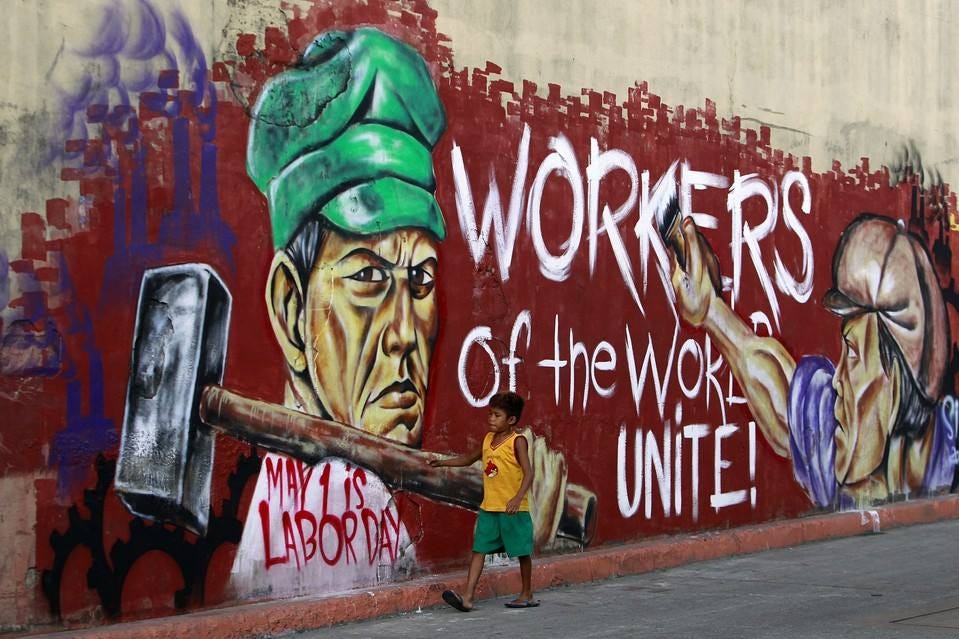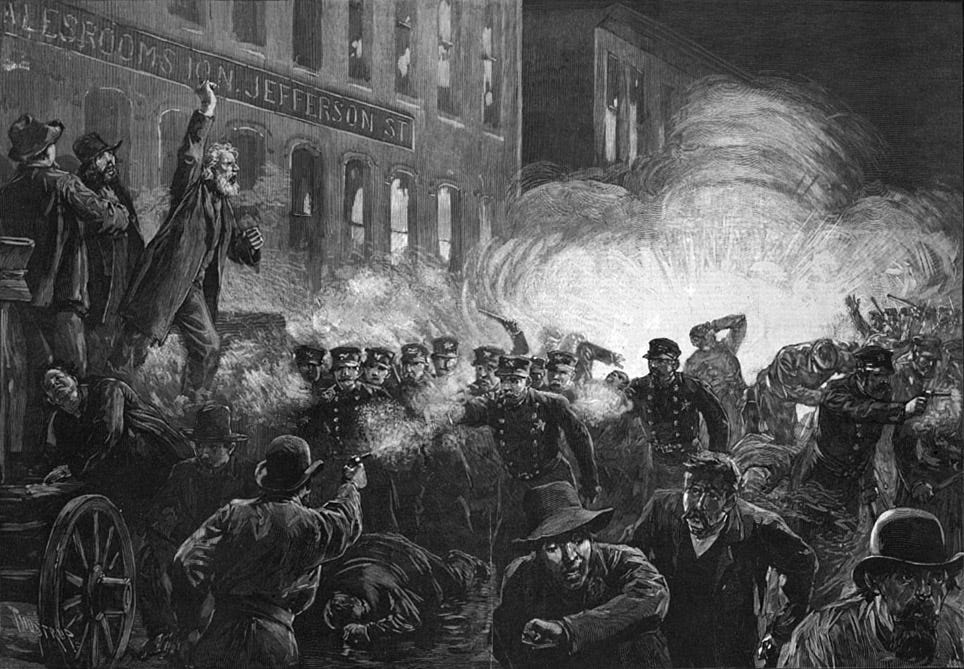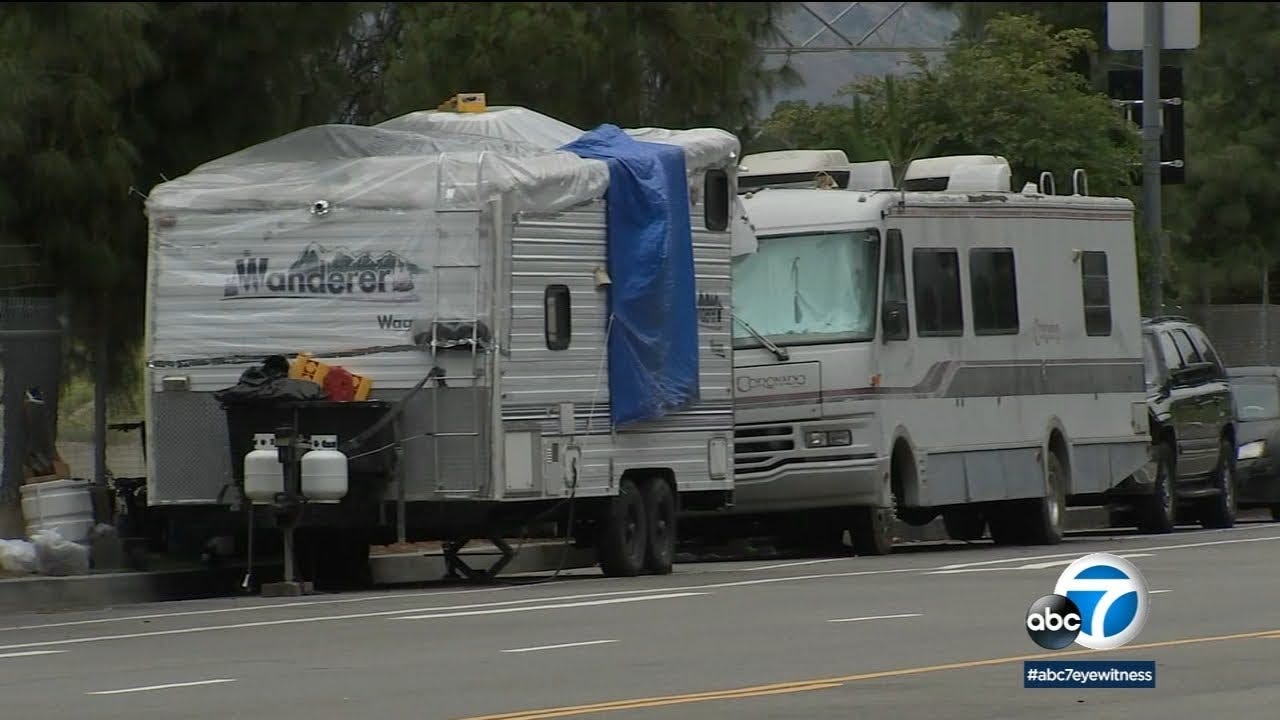...but is any of this working?
Regardless of industry, examining cause and effect is our foremost job duty.
[AJ Freeman *human byline art c/o yurazenvisuals*]
Once again it’s Tuesday afternoon, and that means it’s time to get back On the Job! In this week’s edition, we skipped out on the Labor Day celebration because hey, we had to work anyway.
I’m AJ Freeman, and “This Was a Real Job.”
This Week in Work: M’Aider
I’m sure there are some readers wondering how an employment-focused publication written by a person with a passport issued by the United States could make no timely tribute to yesterday’s “Labor Day” celebrations in the country.
It was a conscious choice, and one I am prepared to explain at some length today.
Anyone who reads “This Was a Real Job” understands that my self-identification with the working people of our world—the hardworking human beings who trade hours of the only life they will ever live for the very essentials of existence—is never to be questioned.
From nurses and teachers to actors, fast food workers and the TSA, I will always stand on your side, and everything I ever write, speak, or sing will be in your advocacy.
We the workers give society its shape, and true peace is impossible as long as we face injustice. Solidarity, forever and always.
So it’s certainly not “Labor” I take issue with, but the “Day” in question.
You see, the fact is that you Yanks have been lied to about Labor Day…and I’m not just talking about those pedantic spelling debates that give the artificial British-American rivalry its colour.
No, the issues with purported celebrations of labor in the US are a matter of perspective.
The interested observer will note that in most of the world, workers are celebrated on May 1, also known as May Day…and the spark for the celebration was lit in the Land of the Free back in 1886.
Folks had gotten real uppity of late about their worker rights, what with the end of legalized private slavery less than 20 years back raising the pay floor in many industries well above “zero.”

Amid such a staggering socioeconomic transformation, workers began to form dangerous new ideas about their relationship to their jobs. These were only exacerbated after the events of 30 April 1886, in which a local factory worker was killed and many others were injured near the end of a long day of work.
Seeing a coworker casually crushed by heavy machinery to the indifference of bosses can offer a glimpse into a possible future for you…hell, a similar incident during my time processing packages for a major shipping company it’s part of what “radicalized” me.

The next day, known in modern times as May Day but then just the first of the month, there was a massive demonstration at Chicago’s Haymarket Square demanding the work day be shortened to a leisurely 8 hours.
As is tradition, the police were on the wrong side of the power struggle, and soon arrived on scene at the request of employers to harass and intimidate citizens peacefully protesting.
By the 3rd day of demonstrations, things took a turn for the predictable when police fired into the crowd, extrajudicially killing a few members of the public.
It is said that if you have a problem, and then call the police, you now have at least two problems…here, Chicago suddenly had between 3 and 7.
The powder keg was lit, and the infamous Haymarket Massacre had begun.
The 4th day of demonstrations brought a serious vibe shift. At first protesting peacefully—i.e., walking around in the street—having a few among them murdered really made the striking workers kinda cranky. The labor strike grew into a fierce protest against police violence, and we all know how those turn out.
Eventually one demonstrator, demonstrating what can happen when the people’s reasonable requests are not met, launched a homemade bomb at the police position…and if there’s anything police hate, it’s being treated like anyone else.
Reports on what transpired next are fuzzy, and in some cases, directly contradictory. Some say the crowd fired the first shot that day, others say the first shots were fired when two to six people were killed the day prior.
What history brings to us undisputed is that on 4 May 1886, 4 demonstrators and 7 police lay dead in the streets of Chicago, with scores more on each side seriously wounded decades before the invention of the ambulance.
We can fast-forward through the rest of the story at Haymarket—we all know that only the demonstrators were punished, the cops slid off stainless, and everybody left able to work eventually calmed down and went back to work.
We even got that 8 hour work day eventually, and so although the workers may have lost the battle, once can argue that they claimed victory in that war.
The worldwide workers’ movement took due note of the events of 1 May 1886 and the turbulent week thereafter, and so when a wave of general strikes were organized across Europe and around the world a few years later, they were set for that date, specifically to honor those martyred at Haymarket Square.
May Day endures to this day in many countries.
However, a cacophonously conspicuous absence from the worldwide celebration of May Day is the country where the Haymarket Massacre took place. Instead, when it came time to select an official worker celebration day in the United States, a date was adopted to coincide with a much tamer labor action, one where agents of the state did not murder citizens exercising their legal rights.
Just another masterful marketing display from the world’s best-branded nation.
.In some circles, that’s called “erasure,” but by any name, September’s Labor Day is a smokescreen to help obscure the fact that people fought, bled and died for every right you enjoy at work.
That weekend you just enjoyed, the 8 hour workday (that hasn’t gotten shorter in about 100 years), wild, radical ideas like paid leave and severance…every inch of it was pulled out of the most zealously guarded reserves of the elite, typically by force.
We would do well to always keep that in mind…and downplaying May Day with a diet labor holiday is a pretty good way to ensure that citizens of the world’s leading wealth extraction enterprise kinda forget.
Here’s hoping now you won’t.
Maybe Update Your Resume: Vanlords?
While we’re on some particularly productive subject matter today, just this morning I was reading a piece from an angry education worker contending that despite the drastic drop-off in US-based manufacturing jobs, the industrial ages never ended in the country…instead, their concepts have been applied elsewhere.
Have you ever wondered why schools are looking more and more like warehouses these days? Well, wonder no more…they essentially are, and these are where future workers are stored at public expense.
There is no defined “product” as the end goal of a process, only assets and liabilities: we can make X amount by investing Y resources for a period of Z time, and X+ by minimizing Y and Z.
Start a charter, collect some kids, feed them molecules, and teach them just enough stuff so they can count change and read employee memos at a company you also own while sucking up those subsidies every step of the way.
The recipes are simple, it’s why you can get a degree in just “business.”
As I always mention, all my SAT points came from the English section, but the math lesson did bring to mind how to some extent, the same is true of housing.
It gets more and more apparent the more you think it over. Housing isn’t, like, places for people to watch fulfilling lives unfold or anything silly like that. It is an investment opportunity, a chance to insert oneself between a supply and a demand. In this context, it is a place to store a worker until it is needed again.
Through this view of the world spanning the width of a drinking straw, it’s easy to see the rationale of a vanlord.
Now, in case you’ve not heard the word, a vanlord is an entrepreneur who has identified a target market in people lacking secure housing and delivered a market solution in the form of broken-down trailers lining the streets of American City.
These debatable dwellings are often located on the private property of a vanlord, and rigged up to makeshift electrical systems to provide basic utility. There is typically no running water, and sewage is handled the very old fashioned way.
Lookit, I’m not here to comment on the morality of the business matter…as always, this is an entirely apolitical publication, and so I leave evaluations to the reader.
Sure, it might look like some haughty, sneering vision of a resource-producing country halfway around the world (or one border over), but with average housing prices in cities such as LA, where the vanlord phenomenon is most prominent, quickly approaching the $3k mark, it’s easy to see where the perceived value of these…um, homes…lie.
I once knew a guy who had a job and lived in a subway station. It’s hard out here.
…but that being typed, is what these vanlords deliver actually value?
That’s the question set to be answered in Los Angeles City Hall this year, as City Councilmember Traci Park has introduced an initiative to expand the LA housing code to more precisely govern these types of arrangements.
Whichever end of the debate you find yourself on, LA vanlord Greg William knows more about the matter than most.
According to a local article, he owns 15 of these unofficial units, by his own estimates accumulating over $8k monthly and earning his self-appointed title of “homeless advocate” from the endeavor.
Courts have repeatedly ordered William to remove his campers from a given city street, which provided him with ample opportunity for malicious compliance as they are mobile homes and can be easily transported to someplace not specifically mentioned in the court order.
Like I said, you can’t deny the savviness of the business model.
Of course, Greg William isn’t the only vanlord in LA, and LA is far from the only place in the US where rolling hovels have become coveted housing options for the working urban public.
Indeed, quite a few individuals have figured out that you can buy some walls on wheels too busted up for a trailer park for a couple thousand dollars and make your money back next month from someone with gainful employment and a desperate situation.
These are the spectacular symptoms of systematic shortcomings.
Still, with shifting public sentiments and a murky legal atmosphere, odds are that vanlords will have to get a real job one day soon…that’s the free market, baby.
Talent Visa Tracker: Czech Republic
Despite the best efforts and fondest wishes of the capital class, the remote work revolution remains strong across the Global North.
Try as they might, those who have made ill-advised investments in commercial real estate anchors in an era of globalized labor just can’t make a 2-hour daily commute in Charlotte seem more appealing than working at your own pace in a place that aligns with your individual interests.
As a result, nations around the world have taken an interest in attracting these new potential sources of tax revenue with what are colloquially called “digital nomad visas,” allowing workers from abroad to gain temporary or permanent residence…the latest on the list is the Czech Republic, whose friends call it Czechia.
The landlocked nation has a moderate oceanic climate, which makes it a great choice for the avoiding the brutal summers (well, up until recently) and/or inhospitable winters common in most TVT countries so far.
The Czech Republic is the modern result of a long history in one of the world’s most traditionally tumultuous regions.
Once part of Bohemia, then half of Czechoslovakia, then a Soviet satellite state, today an EU member, Czechia has continually been redefined, particularly over the last century or so, giving it a certain societal receptiveness to changing times.
Nestled among rolling hills and valleys, its capital city of Prague has an international reputation as an artist-friendly locale.
This perception extends back centuries, as the ruling class of the area’s past placed a strong premium on creative pursuits that appealed to their Bohemian sensibilities. This emphasis on aesthetics is reflected in the capital, with its picturesque bridges and spires…in fact, it is widely known as “the handsomest city of Europe,” which must surely rankle a certain image-forward French city.
As with any city popular with artists, Prague is also known for its drinking culture. Where vineyards dominate Moravia, the country’s other province, Bohemia in general (and Prague specifically) is recognized as a hub of internationally-recognized breweries.
In fact, the Pilsner style of beer originates in the nearby town of Pilsen.
Most of Czechia was built centuries ago, and so there are also plenty of castles and shit if you’re into that kind of thing. Unlike the boot-licking British, they even took the essential step of removing the so-called royals from these great public works to allow added room for tourists and the revenue they bring.
If spending a while at work in the Czech Republic sounds as appealing to you as it does to me, there are only a few hoops to jump through.
First, once you meet the residency requirements, you must apply for a visa and wait for a response from the embassy, which may take up to 120 days.
Next, you must undergo an interview at the Czech embassy where you have applied for a visa.
The interview is designed to assess you as a potential resident, and guidelines advise that applicants be on time, answer all questions truthfully, and be “presentable,” which is a fun dress code to figure out in the actual birthplace of Bohemian values.

If and when approved, you may travel to the country, where you must register your stay of six months to a year with the Foreign Policy within 72 hours of your arrival. You will receive a certification stamp, which you must submit to your local trade office along with your documentation. In a few days, you will receive your trade license, after which you can finally join that remote Zoom meeting.
A central benefit to pursuing residency in the Czech Republic is that the nation is squarely in the Schengen Area, allowing easy access to practically the entire European continent thanks to well-developed political systems and public transportation options that would be unrecognizable on this side of the planet.
When your working period in Czechia has expired, you may reapply for an extension provided you are in good domestic standing…by then you’ll certainly figure out whether life in the country is for you, but the important part is you won’t be in Kansas (or wherever) any more.
Hope Spot: Leading the Charge
Finally, this week’s Hope Spot has European origins, but may soon make appreciable waves around our world.
In the fifteenish years since the release of the original iPhone, the device has gone from status symbol to part of the public consciousness.
For instance, I heard this latest development on the broadcast news, right in between a segment on that day’s mass shooting and rumblings of major labor action from the national Union of Automotive Workers, which may be the subject of a future Hope Spot. Pretty important stuff, that iPhone.
The closed ecosystem that many of its users consider its strongest benefit has its pros and cons—some people enjoy being able to brag about the color of their messaging bubbles—but one of the most commonly cited drawbacks to iOS equipment is the dependence on manufacturer peripherals, which of course carry the premium prices associated with the Apple brand.
That might be about to change thanks to a recent ruling out of Europe forcing smartphone manufacturers selling products in the EU to adhere to a standard charging cable.
As a result, in advance of the company’s big yearly conference with the big stupid name, rumors abound that iPhones all over the world may be standardizing their charging cables…turns out it’s just cheaper to cut the bullshit than develop two versions of the same product to sell a few extra accessories.

I speculated in an earlier edition that the ruling out of Japan on AI creations would have greater implications on worldwide copyright law, and the effect of rulings by high-profile governments is on display in this scenario.
This is, in an unexpected form, a powerful demonstration of collective bargaining’s potency. Either you alter your business plan, or else lose access to one of the largest and most lucrative markets on the planet.
Those are the options.
We' shall soon see what Apple does, but my guess is they ditch the stupid charger.
Now, is this the strongest case for the future’s hope? Eh.
…but if you squint just hard enough, you might be able to see a timeline where the expense of bad business outweighs the profit potential.
When it’s easier to imagine the end of the world than a future made fair, that’s about all the hope you can ask for I guess.

















